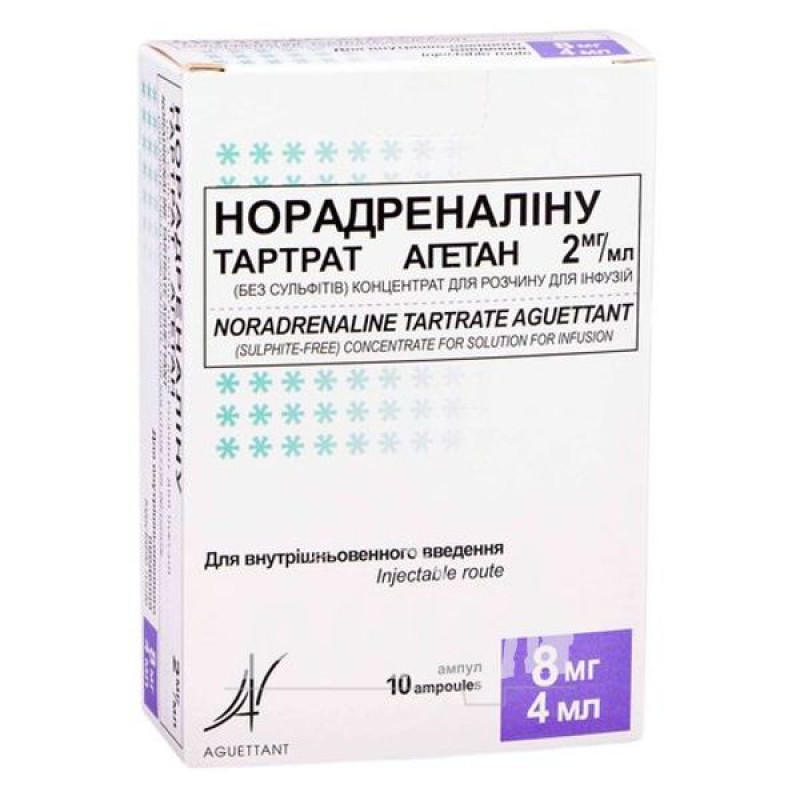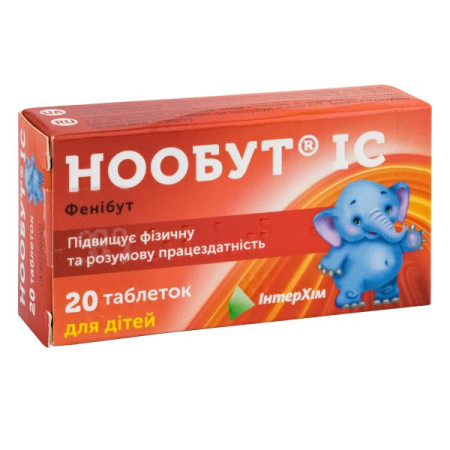Noradrenaline tartrate agetan 2 mg/ml concentrate for solution for infusion 2 mg/ml ampoule 4 ml in blisters No. 10

Concentrate for solution for infusion "Noradrenaline tartrate Agetan 2 mg/ml (sulfite-free)" is indicated for urgent (immediate) restoration of blood pressure in cases of acute hypotension.
Composition
The active substance is noradrenaline (1 ml of concentrate contains 2 mg of noradrenaline tartrate; one ampoule contains 8 mg of noradrenaline tartrate, which corresponds to 4 mg of noradrenaline base).
Excipients: sodium chloride, sodium hydroxide or hydrochloric acid, water for injections.
Contraindication
The use of norepinephrine concentrate 1 mg/ml for the preparation of infusion solutions is contraindicated in patients with hypersensitivity (allergic reaction) to norepinephrine or any of the excipients. Arterial hypotension due to insufficient blood volume (hypovolemia, decreased circulating blood volume). The use of pressor amines during cyclopropane or halothane anesthesia can cause severe cardiac arrhythmia. Due to the possible increased risk of ventricular fibrillation, norepinephrine should be used with caution in patients receiving these or any other sensitizing drugs for the heart or in whom there is increased hypoxia (oxygen deficiency) or hypercapnia (increased carbon dioxide content in the blood or tissues).Method of application
Adult patients
Initial infusion rate (intravenous administration): The initial infusion rate should be 10 ml/h to 20 ml/h (0.16 ml/min to 0.33 ml/min). This is equivalent to 0.8 mg/h to 1.6 mg/h of noradrenaline tartrate (or 0.4 mg/h to 0.8 mg/h of noradrenaline base).
Dose selection
Immediately after the norepinephrine infusion is established, the dose should be adjusted according to the pressor effect observed. There is considerable variation in the dose required to achieve and maintain normal blood pressure in patients. The main aim is to achieve a low normal systolic blood pressure (100-120 mm Hg) or to achieve an appropriate mean blood pressure (above 65-80 mm Hg, depending on the patient's condition).
If other solutions are used, careful dose calculations should be performed before starting treatment.
Duration of treatment and monitoring
Treatment with noradrenaline should be continued as long as vasoactive drug support is indicated. The patient should be closely monitored and supervised throughout the period of noradrenaline treatment.
The infusion may be stopped suddenly, it should be stopped gradually to avoid a sudden drop in blood pressure.
Elderly patients
Elderly patients may be particularly sensitive to the effects of norepinephrine.
Application method
For intravenous administration only.
Noradrenaline should be administered using central venous devices to minimize the risk of extravasation (leakage of the drug from the vessel into the surrounding tissues) and subsequent tissue necrosis.
Noradrenaline concentrate 1 mg/ml must be diluted with 5% glucose or normal saline before intravenous administration. It should not be mixed with other medicinal products.
The final concentration of the infusion solution should be 80 mg/liter of noradrenaline tartrate, which is equivalent to 40 mg/liter of noradrenaline base.
Dilution instructions
Add 2 ml of Noradrenaline 1 mg/ml to 48 ml of 5% glucose (or isotonic glucose solution) for administration by syringe infusion pump or add 20 ml of Noradrenaline 1 mg/ml to 480 ml of 5% glucose (or isotonic glucose solution) for administration via drip.
In both cases, the final concentration of the infusion solutions is 80 mg/liter of noradrenaline tartrate, equivalent to 40 mg/liter of noradrenaline base. If other solutions are used, careful dose calculations should be performed before starting treatment.
Blood pressure control
Measure blood pressure every two minutes at the beginning of the infusion until the desired blood pressure is reached. Then every 5 minutes when the desired blood pressure is reached, if necessary, continue the infusion. The rate of infusion should be monitored, and the patient's condition should be closely observed throughout the period of treatment with noradrenaline (norepinephrine).
Application features
Pregnant women
Noradrenaline may adversely affect placental blood flow and cause fetal bradycardia. It may also affect uterine contractions in pregnant women and lead to fetal asphyxia in late pregnancy. Therefore, careful consideration should be given to whether the expected benefit to the mother outweighs the potential risk to the fetus.
There is no information on the use of norepinephrine during breastfeeding.
Children
The safety and effectiveness of the drug in children have not been established.
Overdose
In case of overdose, the following may occur: vasoconstriction of the skin, pressure sores, vascular insufficiency, arterial hypertension.
In case of adverse reactions associated with excessive dosage, it is recommended to reduce the dose if possible.
Side effects
On the part of the heart: tachycardia, bradycardia (possibly as a reflex result of increased blood pressure), arrhythmia, palpitations, increased contraction of the heart muscle (myocardium) as a result of the ß-adrenergic effect on the heart (inotrope and chronotrope), acute heart failure.
From the side of the central nervous system: anxiety (restlessness), sleep disturbances (insomnia), confusion (darkening of consciousness), headache, psychotic states, weakness, tremor, deterioration of attention and vigilance, anorexia, nausea and vomiting.
On the part of the urinary system: urinary retention.
Respiratory system: respiratory failure or difficulty breathing, shortness of breath (dyspnea).
Local reactions: irritation and necrosis at the site of drug administration are possible.
On the part of the organs of vision: acute glaucoma; very often occurs in patients who are anatomically predisposed to closure of the iridocorneal angle (the angle of the anterior chamber of the eyeball).
With prolonged use of vasopressors (vasoconstrictor drugs) to maintain blood pressure in the absence of restoration of circulating blood volume, the following symptoms may occur:
severe constriction of peripheral and visceral vessels; decreased renal blood flow; decreased urination; hypoxia (oxygen deficiency); increased serum lactate levels.In case of hypersensitivity (allergic reaction) or overdose, the following symptoms may occur more frequently: arterial hypertension, photophobia, chest pain, pain in the larynx, pallor, increased sweating and vomiting.
The vasopressor effect (resulting from adrenergic action on the vessels) can be reduced by co-administration of an α-blocker (phentolamine mesylate), while the use of ß-blockers (propranolol) can result in a decrease in the stimulating effect of the drug on the heart and an increase in the pressor effect (due to reduced dilation of the arterioles) resulting from ß1-adrenergic stimulation.
Prolonged use of any potent vasopressor may result in a decrease in plasma volume, which must be continuously corrected by appropriate fluid and electrolyte replacement therapy. If plasma volume is not corrected, hypotension may recur when noradrenaline is discontinued, or blood pressure may be maintained with the risk of severe peripheral and visceral vasoconstriction with decreased blood flow.
Interaction
The drug must not be mixed with other drugs, except 5% glucose or isotonic glucose solution.
Storage conditions
Store in the original packaging at a temperature not exceeding 25 °C, out of the reach of children.
Shelf life - 2 years.
There are no reviews for this product.
There are no reviews for this product, be the first to leave your review.
No questions about this product, be the first and ask your question.





